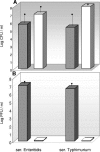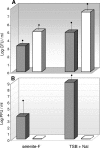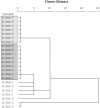Bacteriophages may bias outcome of bacterial enrichment cultures
- PMID: 16085813
- PMCID: PMC1183318
- DOI: 10.1128/AEM.71.8.4269-4275.2005
Bacteriophages may bias outcome of bacterial enrichment cultures
Abstract
Enrichment cultures are widely used for the isolation of bacteria in clinical, biotechnological, and environmental studies. However, competition, relative growth rates, or inhibitory effects may alter the outcome of enrichment cultures, causing the phenomenon known as enrichment bias. Bacteriophages are a major component in many microbial systems, and it abounds in natural settings. This abundance means that bacteriophages are likely to be present in many laboratory enrichment cultures. Our hypothesis was that bacteriophages present in the sample might bias the enriched subpopulation, since it can infect and lyse the target bacteria during the enrichment step once the bacteria reach a given density. Here we show that the presence of bacteriophages in Salmonella and Shigella enrichment cultures produced a significant reduction (more than 1 log unit) in the number of these bacteria compared with samples in which bacteriophages had been reduced by filtration through 0.45-microm non-protein-binding membranes. Furthermore, our data indicate that the Salmonella biotypes isolated after the enrichment culture change if bacteriophages are present, thus distorting the results of the analysis.
Figures



Similar articles
-
Isolation and Characterisation of Bacteriophages with Activity against Invasive Non-Typhoidal Salmonella Causing Bloodstream Infection in Malawi.Viruses. 2021 Mar 15;13(3):478. doi: 10.3390/v13030478. Viruses. 2021. PMID: 33804216 Free PMC article.
-
Isolation of lytic bacteriophages infecting Salmonella Typhimurium and Salmonella Enteritidis.Acta Biol Hung. 2018 Sep;69(3):350-369. doi: 10.1556/018.68.2018.3.10. Acta Biol Hung. 2018. PMID: 30257585
-
Phage-type specific markers identified by Diversity Arrays Technology (DArT) analysis of Salmonella enterica ssp. enterica serovars Enteritidis and Typhimurium.J Microbiol Methods. 2010 Jan;80(1):100-5. doi: 10.1016/j.mimet.2009.10.008. Epub 2009 Oct 20. J Microbiol Methods. 2010. PMID: 19852988
-
Isolation, characterization, and application of bacteriophages for Salmonella spp. biocontrol in pigs.Foodborne Pathog Dis. 2014 Aug;11(8):602-9. doi: 10.1089/fpd.2013.1600. Epub 2014 May 13. Foodborne Pathog Dis. 2014. PMID: 24823991
-
[The presence of bacteriophages in human feces and their potential importance].Pol Merkur Lekarski. 2006 Oct;21(124):381-3. Pol Merkur Lekarski. 2006. PMID: 17205783 Review. Polish.
Cited by
-
Don't Shut the Stable Door after the Phage Has Bolted-The Importance of Bacteriophage Inactivation in Food Environments.Viruses. 2019 May 22;11(5):468. doi: 10.3390/v11050468. Viruses. 2019. PMID: 31121941 Free PMC article. Review.
-
Co-enriching microflora associated with culture based methods to detect Salmonella from tomato phyllosphere.PLoS One. 2013 Sep 9;8(9):e73079. doi: 10.1371/journal.pone.0073079. eCollection 2013. PLoS One. 2013. PMID: 24039862 Free PMC article.
-
Simultaneous Salmonella and bacteriophage isolation on Modified Semisolid Rappaport Vassiliadis media.Poult Sci. 2023 Oct;102(10):102960. doi: 10.1016/j.psj.2023.102960. Epub 2023 Jul 25. Poult Sci. 2023. PMID: 37579648 Free PMC article.
-
Antibiotic resistance genes in the bacteriophage DNA fraction of environmental samples.PLoS One. 2011 Mar 3;6(3):e17549. doi: 10.1371/journal.pone.0017549. PLoS One. 2011. PMID: 21390233 Free PMC article.
-
Novel Escherichia coli-Infecting Bacteriophages Isolated from Uganda That Target Human Clinical Isolates.Phage (New Rochelle). 2023 Sep 1;4(3):141-149. doi: 10.1089/phage.2023.0012. Epub 2023 Sep 20. Phage (New Rochelle). 2023. PMID: 37841386 Free PMC article.
References
-
- Adams, M. H. 1959. Bacteriophages, p. 27-30. Insterscience Publishers, Inc., New York, N.Y.
-
- Anonymous. 1975. Council directive of the 16 of June concerning the quality required of surface water intended for the abstraction of drinking water in the member states (75/4400/EEC). Off. J. Eur. Commun. L194:26-31.
-
- Anonymous. 1991. Council directive of 15th of July lying down the health conditions for the production and placing on the market of live bivalve molluscs (91/492/EEC). Off. J. Eur. Commun. L268:1-13.
-
- Anonymous. 1995. ISO 6340: water quality. Detection and enumeration of Salmonella. International Organisation for Standardisation, Geneva, Switzerland.
-
- Anonymous. 1998. Standard methods for the examination of water and wastewater, 20th ed. American Public Health Association, Washington, D.C.
Publication types
MeSH terms
Substances
LinkOut - more resources
Full Text Sources
Other Literature Sources

